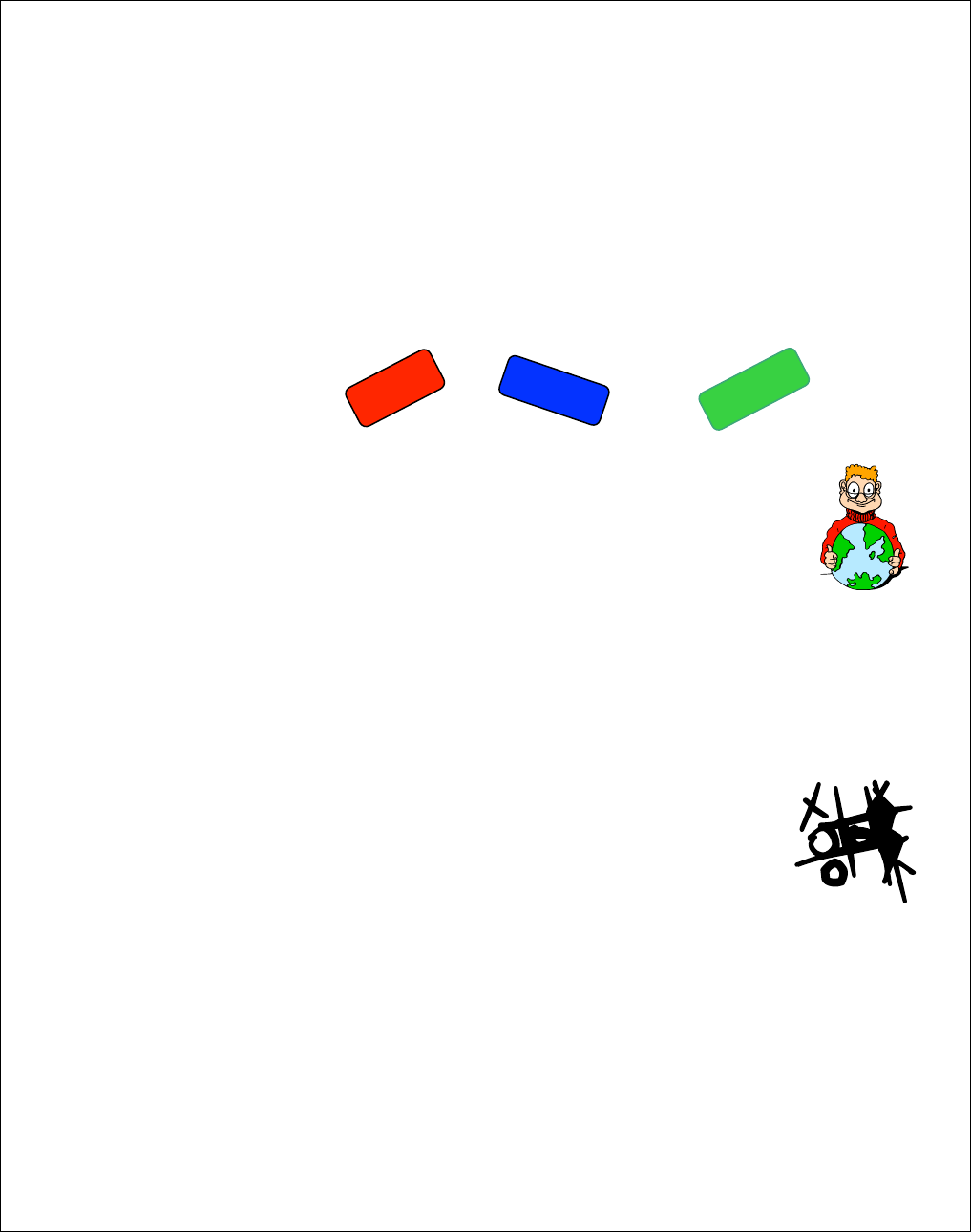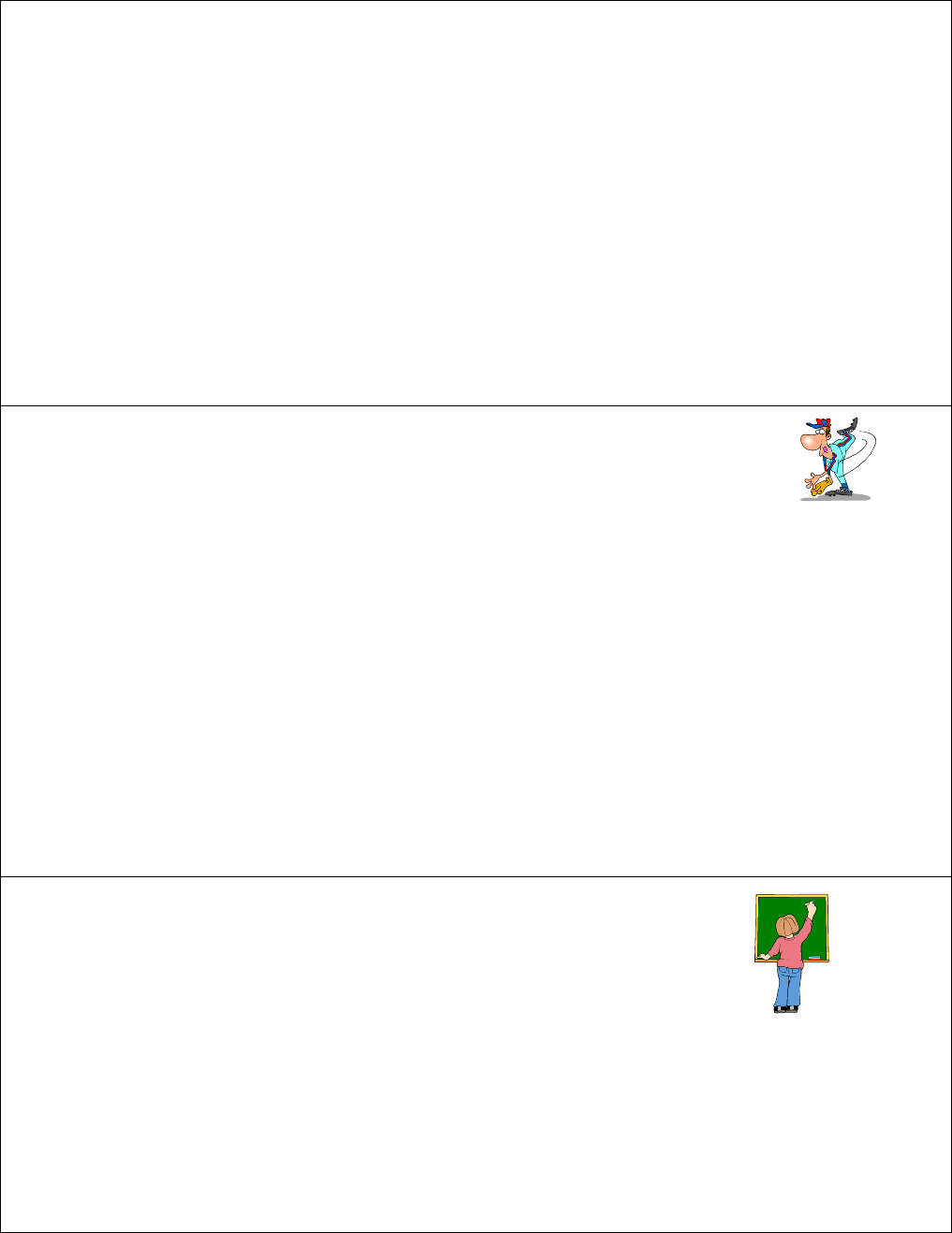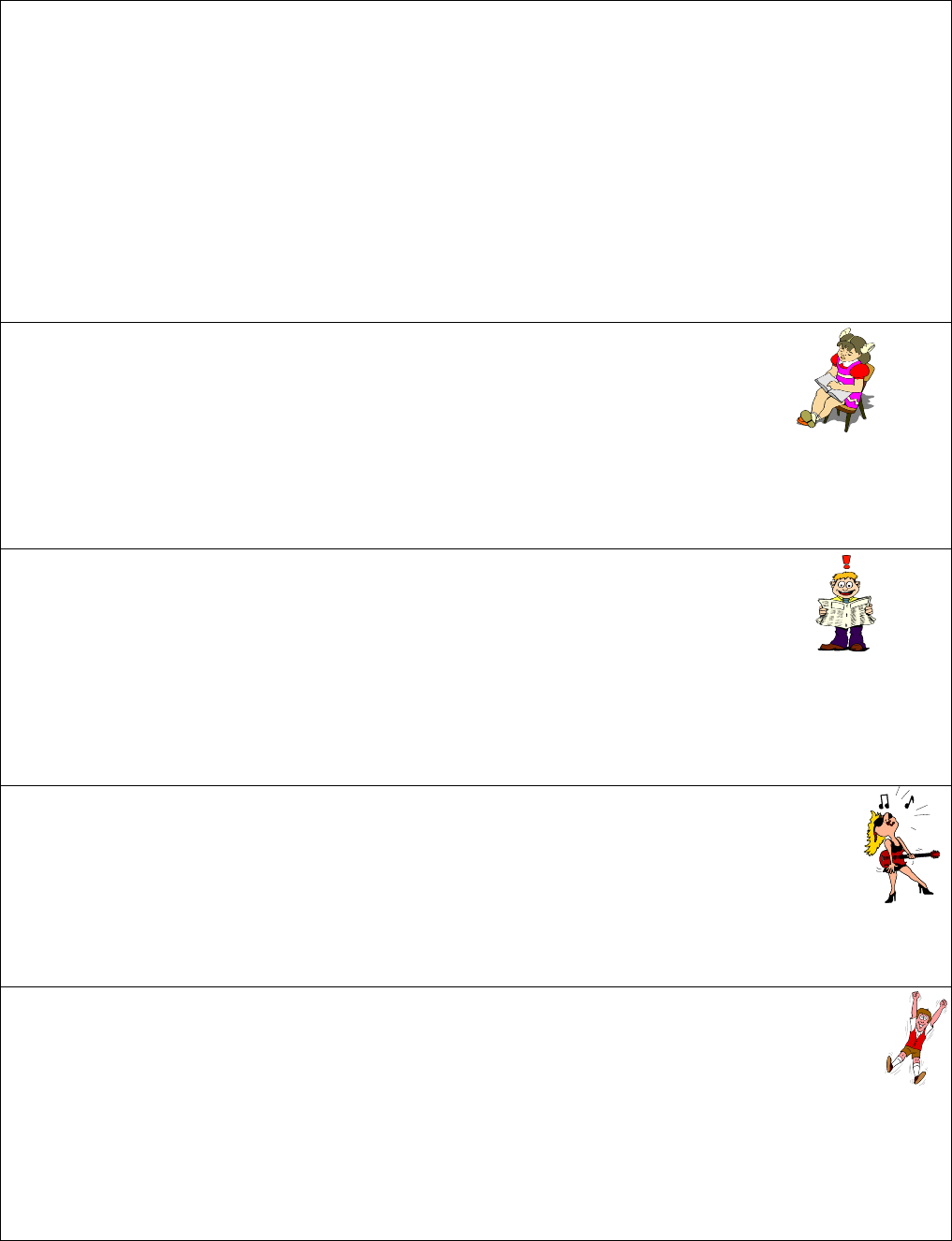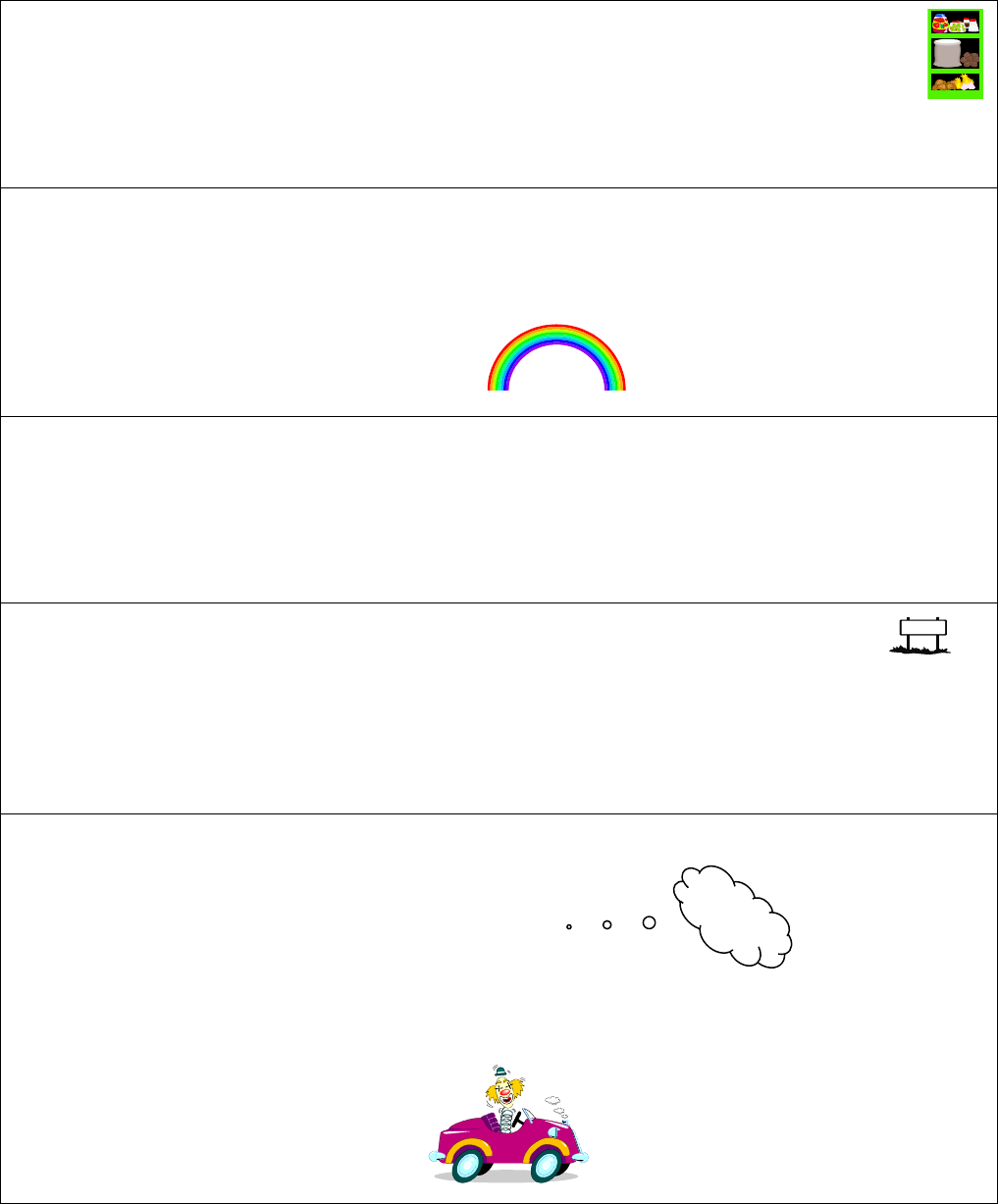
Sight Words:
Multisensory
Activity Packet
Sight words like
come
,
does
, or
who
don’t follow the rules of
writing or the six syllable types. These words have to be
memorized because decoding them is difficult. Students are
taught to memorize sight words as a whole so they can recognize
them immediately (within three seconds) and read them without
having to use decoding skills.
By the end of first grade, your child should know how to read
all 200 sight words on the provided list “in a snap” (see separate
document).
If your child masters reading ALL the words correctly on the
list, he or she will practice writing/spelling the sight words.
Attached are some ideas to make sight word practice fun and
hands-on. Your child can choose any of the activities in this
packet, or do something else entirely. Feel free to be creative!
Thank you for your unending support at home.
Mrs. Hopper

Activities to Reinforce and Teach Sight Words
Bean Bag Toss
Materials: One shower curtain liner divided into 20 boxes with a permanent marker
Bean Bag
Words on large cards
Attach the words to the shower curtain with tape or rubber cement before the game is
being played. Put the small numbers on the corner of the cards. Divide into 2 teams. Each
team will take turns throwing the bean bag to a square. If the student can read the word
the bean bag lands on, the team gets the number of points on the card. If the student
misses the word, the other team gets the chance to say it. The team with the most
points wins the game.
Around the World
Materials: Word Cards
Sit in a circle. One student stands behind another student who is sitting. The teacher
flashes them a sight word. Whoever says it first moves on to the next student. The
student that makes it back to their own desk or starting point is the winner. This is a
pretty popular game, but the little ones love to try to stop someone who is making it
"Around the World"!
Tic Tac Toe
Materials: Chalkboard with the tic tac toe board drawn on it
Word Cards
Divide into X’s and O’s teams. Write words in the tic tac toe spaces. Take turns having a
member of the team come up and selecting a space to read. If s/he is correct, they may
put an X or O for their team. If they are incorrect, the other team gets to send a player
to the board to try the same word. You can keep score if you want.
*You can also give everyone a blank copy of the tic tac toe board, and put the list of
words on the board. Have them place the words where they want in their board. As you
call the words out, you will have to say if it is an X word or an O. The first one to tic tac
toe is the winner.

Wordo
Materials: Blank "Wordo " cards (similar to “BINGO” cards) with 9, 16, or 25
blocks.
Copy of words being studied
Have students fill in the card with the words that you are working on. Tell them
that each card will be different and to try to mix up the words they are using.
Playing the game is just like BINGO. Call out the words and have the students
spell it out loud with you and then mark their spaces. This will give those who are
unsure of the word some extra help. The first one with a row covered calls out
the word "WORDO"! Let the winner be the one who calls out the words the next
time.
Baseball
Materials: Put sight words on different colored cards and have the type of hit that each
represents on each color posted somewhere that everyone can see it clearly.
Places in the room marked as 1st base, 2nd base, 3rd base, and home plate.
Divide into 2 teams and let them name themselves. Designate one team as home, and the
other as visitors. Mix up the cards. One child goes to the home plate. Draw out a card.
Match the color to the type of hit they are trying for. If the student can read the card
correctly, they may move according to the type of hit. (A single –move 1 base, a double -
move 2 bases, a triple-move 3 bases, and a homerun-go all the way to home plate.) Make
sure that you have some strike out cards in the word cards also. If the student is unable
to read the word, it is considered an out. After 3 outs, the next team gets to "bat." Keep
the score so that everyone can see.
Erase Relay
Materials: Word lists on a dry erase board
Write two columns of words on a dry erase board that are approximately equal in
difficulty. Write as many words on the board as there are children in the relay. Children
are divided into 2 teams, and stand in two lines at right angles to the chalkboard. At the
signal, the first child in each line points at the first word in his respective column of
words and pronounces that word. If his pronounces it correctly, s/he is allowed to erase
that word. The game is won by the side that erases all the words first.

Team Sight Word Race
Materials: A group size set of sight words
The children are divided into 2 teams. Each team takes a turn attempting to pronounce a
word turned up from a pile of sight words. If one team misses, the opposite team then
receives a chance to pronounce that word in addition to their regular turn. Score is kept
on the number of words each team pronounces correctly. Do not have members sit down
when they miss a word, but have each team member go to the back of the line after each
try whether successful or not. This enables all members to gain equal practice and does
not eliminate those people who need practice most.
The Head Chair
Materials: Group size cards
Mark one chair in the circle as the "Head Chair". Play begins when you flash a card to the
person in the "Head Chair." A child can stay in his/her chair only until s/he misses a word.
When s/he misses a word, s/he goes to the end chair and all the children will move up one
chair. The object of the game is to try to end up in the "Head Chair.”
Which Word Wins?
Materials: newspaper, highlighter, word list
Sit with your child and look at a newspaper to see just how often sight words pop up in
print. Ask your child to choose a sight word from the list and an article from the
newspaper. Look for the word together. Highlight and count the word each time it
appears. Try the same thing with a second sight word. Which word appears more often?
Sing a Song of Sight Words
Practice sight words by singing them to a familiar tune or making up your own.
If you run out of words before you get to the end of the song, just start at the top of
the list again. Some songs to try include “Twinkle, Twinkle, Little Star” and “Row, Row,
Row Your Boat.”
Jump On It!
Copy sight words on index cards (one word per card). Make a second set of the same
words. Scatter one set faceup on the floor, leaving about a foot between each card. Place
the other set in a stack facedown. Turn over the first card in the stack. Have your child
read the word (offer help as needed) and then jump on the corresponding card on the
floor. Turn over the next card and have your child read it and jump to that word.
Continue until your child has jumped on all of the words. Mix up the cards and play again!

In the Cupboard
Open a cupboard and take turns with your child, finding and reading sight words. Try the
ones on the list first, then include other sight words your child is learning. Keep going until
you run out words, time, or things in the cupboard.
Rainbow Letters
Turn sight words into rainbows! Ask your child to write a sight word on paper in big
letters. Usisng different-colored crayons, your child can then trace around the word
again and again, reading the word each time.
Read My Back!
“Write” a sight word on your child’s back. Can your child guess the word? Trade places—
let your child trace a word from the list on your back. Continue taking turns tracing and
guessing sight words.
On the Run
The next time you’re going somewhere with your child, play a sight word game. It’s easy—
just have your child find as many sight words as he or she can on billboards, signs, and so
on. If you don’t have a sight word list with you, invite your child to read the “little”
words. You can play this game in a car, on a walk, even in line at the grocery store!
Beep!
Choose a picture book to read aloud.
Tell children that whenever they hear the word
Beep!
it means you’ve left out a word.
They need to guess what the word is.
Read the story a second time, this time letting children chime in on as many sight words
as they know.
Beep!

ADDITIONAL SIGHT WORD WORK ACTIVITIES
Paper Plate Toss: Write sight words on paper plates. Use them like frisbees to throw after
reading the word. Add in some additional fun by adding a target.
Flashlight Words: Turn off the lights. Tape words on the wall or ceiling. Use the flashlight to
shine on the word, then have your child read it.
Go Fish: Wish a duplicate set of word cards play “Go Fish.” You can easily make your own
cards out of index cards.
Stepping Stones: Place the word cards on the floor, making a fun stream going across the
room. Have your child walk over the stream. As they step onto the stepping stone (word),
have them say the word before they move on to get to the other side of the stream.
Tic-Tac-Toe: Write words in the tac-tac-toe spaces. Take turns selecting a space to read. If
read correctly, an X or O is placed on the space until someone wins.
Word-O: This is played just like BINGO. Fill in a card with the words that you are working on.
Call out the words and mark the spaces. The first one with a card covered calls out the word
“WORDO!”
Word Hunt: Look for target words in books or in the newspaper. If using the newspaper your
child can highlight or circle the words that she finds.
Word Jump: Write the sight words onto the driveway. Call out a word. Have your child jump
their way to the sight word.
SNAP: You put the sight words you want them to practice on flash cards and put the flash
cards into a jar. Also, you write the word SNAP on a few flash cards and put them in to the
jar. The kids can play in partners or in a groups of 3 or 4 with siblings. They take turns pulling
a card out of the jar. If they can say the word on the card automatically with no struggle, they
get to keep the card. If they struggle, they have to put it back. If they pull out one of the cards
that says SNAP, they have to put all of the card they’ve drawn back. The first person to 5
cards (or 10) wins!
Stair Chase: Place two sight word cards on each stair. Let them pick one sight word on the
way up, saying the word and picking up the card when they get it correctly. Have them
practice the other sight words on the way down.
Coin Toss: Put words on the floor. Children take turns tossing a coin onto a word and saying
the word. If they get the word correctly, they keep the coin. If you like, first to 10 coins wins.
Or see if they can collect all of the coins.
Concentration: Create two sets of word cards. Place the word cards face down. Have your
child turn over two cards, trying to make a match. Continue until all of the words are matched.

Play who am I? Lay out the word cards. Then give the child clues to what the selected word
is. For example, if the word was “red,” you could say – I rhyme with bed. I have three letters. I
end with the letter “d.” Have the child locate the word.
Chalk Writing: Go outside and practice writing the sight words with chalk on the sidewalk.
Beat the Clock: See how many times your child can write a word in one minute. Or see how
many flash cards your child can read in one minute.
Words You Can Eat: Have your child write/spell words in whipped cream, peanut butter,
carrots or using his/her favorite snack.
Who has more? Flash word cards to your child. If he/she reads the word within 5 seconds,
he/she gets to keep the card. If not, you keep the card. If the child has more cards than you
at the end, he/she wins.
Salt Tray: Grab a tray or baking sheet with edges. Pour in salt. Write the word in salt. When
your child says it correctly, he/she gets to erase the word. (You can also use flour or sugar!)
Record and Say/Spell: Tape record your child saying and spelling the words.
Rhyme Time: Write the words. Write rhyming words for each one. Draw a picture to match.
Silly Sentences: Write each word in a silly sentence. Remember to use capitals, periods,
and spaces in between. Draw a picture for one sentence.
Write Questions: Write each word in a sentence that asks a question. Don’t forget the
question marks!
Guess My Word (Writing Style): Write each word. Write two clues to describe each word.
Criss Cross: Look at the word list. Find two words that have the same letter. Write them in
“criss-cross” style: c a t
o
o
Neatly Please: Write each word two times. One time use a pencil and one time use a pen.
Circle the neatest one for each word.
Traffic Light: Write three letter words in traffic light style. The first letter goes on green. The
last on red. The middle goes on yellow.
Tongue Twister: Write a tongue twister sentence for each word. Example for the word “hat”:
Harry has huge hats.
Beginning Match: Write each word two times. Then write a word that starts with the same
letter.

Ending Match: Write each word two times. Then write a word that ends with the same letter.
Vowel/Consonant ID: Write the words with pen and pencil. Use pen for vowels and pencil
for consonants.
Friendly Letter: Write a letter to someone. Use all the words.
Uppercase/Lowercase: Write the words in uppercase letters. Then write them all in
lowercase.
Name Letters Match: Write your name. Write the words from the sight word list. Circle the
letters in each word that are also in your name.
Teacher Teacher: Pretend you are a teacher. Write about what you would do. Use all the
words on the list.
Family Sentences: Write sentences about your family. Use the words from the list.
Plant words: Draw a tall plant with large leaves. Write a word on each leaf.
Hear the Sounds: Write the words. Say each one slowly. How many sounds do you hear?
Write the number for each word.
Friend Sentences: Write about your friend. Use all the words from the list.
Choo-Choo: Make a word train out of all your words.
Yummy Pizza: Draw a large pizza. Write one word on each slice.
Echo Spell: The leader reads a word from the list, spells it clearly, and repeats the word. The
other person echoes back the same thing. Example: cat, c-a-t, cat (then the echo)
Stamp and Clap: Read the word and spell it slowly. Clap when you say a consonant. Stamp
when you say a vowel. Jump when you say “y” because it can act as a consonant or vowel.
Jumping Jacks: Read the word and spell it without looking. As you say each letter, do one
jumping jack.
Ooey Gooey Goulash: Put a small amount of something that is ooey and gooey onto a
dinner plate or cookie tray. Write one word at a time and check the list to see if you got it
correct. Some ooey gooey things that work well are shaving cream, pudding, ketchup, and
watered-down toothpaste.
Try Them Dry: Cover the bottom of a cookie tray with a dry ingredient like sand, flour, glitter,
or rice. Practice spelling/writing each word.
Finger Spell: Say each word and stretch out each sound. Put up a finger for each sound.
Write that number of spaces on a sheet of paper. Fill in the spaces with the sounds you hear.
Look at the word on the list and compare it to what you wrote. Fill in the silent letters and
other letters you missed.

MAKING/WRITING SIGHT WORDS FOR SPELLING PRACTICE
Having your child say the word, spell it, and say it again using:
• Playdough
• Markers or Crayons
• Paint
• Stencils
• Yarn or string
• Wiki sticks
• Alphabet stamps
• Scrabble tiles
• Magnetic letters
• Legos
• Coins
• Buttons
• Popsicle Sticks
• Salt on a Tray
• Sidewalk Chalk
• Sticks (in sand or dirt)
